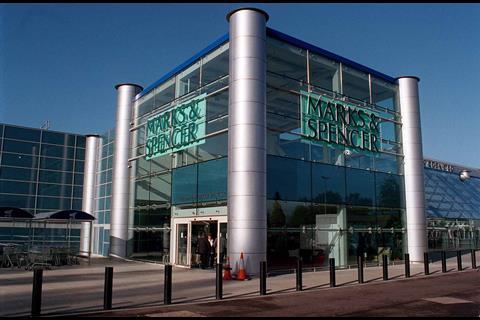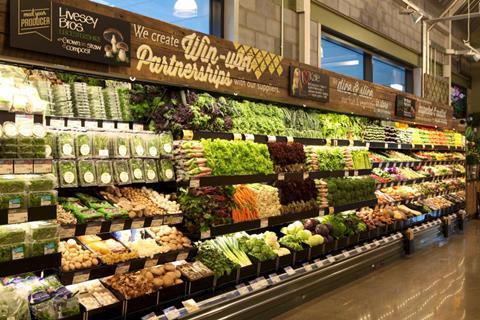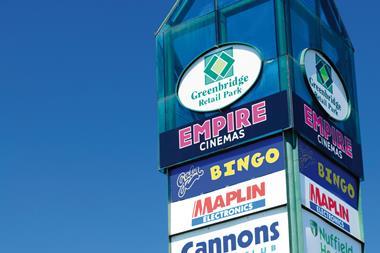While some shopping destinations struggle to stay afloat in the downturn, for the past few years retail parks have been successfully evolving.
When it comes to the success or failure of shopping destinations, the polarisation between the winners and the losers is increasingly acute.
Throughout the downturn, the difference between prime and secondary or tertiary destinations, between soaring vacancy rates and near-capacity lettings, and between increasing footfall and declining visitor numbers has become ever more stark.
Every category has its over- and under-achievers. Shopping centres such as Westfield London, or even St Stephen’s in Hull, are performing well, and the new Trinity Leeds centre was nearly fully let when it opened last month. But at the same time, others languish with empty units and under-investment.
Retail parks too are increasingly polarised. They range from ‘crinkly box’ clusters of a few bulky goods stores to vast shopping parks with a mix of retail and leisure tenants to rival a thriving high street.
Evolving tenant mix
According to the latest vacancy rates figures from the Local Data Company, retail parks still enjoy relative buoyancy compared with other destinations. Retail parks have the lowest vacancy rates, at 8.8%, while shopping centres have the highest vacancy rate average overall, at 15.6%.
The retail park continues to evolve, which may explain its relative success. Some aggressive asset management by owners, including sustained demands for broader consents -allowing for a wider use of units beyond just for bulky goods - has allowed retailers traditionally wedded to the high street to consider out-of-town properties. Over the past years, the mix of tenants in retail parks has become increasingly attractive to a variety of retailers.
Whereas retail parks’ early years were all about bulky goods - furniture, DIY and electricals - a decade ago the tenant mix started to change markedly, gradually introducing a softer mix including Boots, fashion retailers
such as Next, food offers and department stores.

The advantages of retail parks are clear. Jeremy Collins, property director at John Lewis, says: “The primary USP of retail parks has been and remains convenience for both customers and retailers. Ease of access and free parking are considerable advantages.”
Collins says it helps that there is now a broader spectrum of retail warehouse offerings, from standalone units and smaller parks to sophisticated purpose-built destinations, such as Fosse Park in Leicester.
Grand days out
As retail parks have evolved, so too has their tenant mix. Martin Supple, head of out-of-town retail at Cushman & Wakefield, says: “We are continuing to see a broadening of our tenant mix, and we are seeing a widening of retailers who will go into retail parks.”
Retail parks offer a wider range of products as well, says Supple. While 10 years ago, one destination might offer a single category of product, such as home improvement, the balance is now increasingly sophisticated
and subdivided, similar to that found in shopping centres.
Out-of-town retailing used to be all about DIY retailers, but nowadays the mix is varied - babycare retailer Kiddicare and pets specialist Pets at Home are just two recent successes.
Other high-profile moves away from the high street include department stores. Debenhams, for example, continues to plan out-of-town locations after signing with Land Securities’ Ravenside Retail Park in Chesterfield last year. The store is due to open this summer. Fashion giants such as H&M and Primark have also made moves, sometimes very tentatively, onto the parks. Whole Foods, meanwhile, recently opened an experiential store in Cheltenham’s Gallagher Retail Park, and British Land has just signed Schuh for its Teesside Shopping Park. The footwear retailer’s first out-of-town store will open later this year.
In addition, amenities such as coffee shops have helped create the whole retail package. Briant Champion Long client Costa Coffee, for example, had only a handful of units in retail parks five years ago, and now has about 150, according to Briant Champion Long partner Dan Simms. Even banks are adding to the mix. Metro Banks is actively expanding its retail park presence, according to its agent Supple. Such additions in turn increase much-sought-after dwell time.
Childcare retailer Mamas & Papas has 64 stores, with 39 of those in retail parks. Over the past two years, 50% of its new store openings have been in retail parks, according to Joanna Formby, senior retail marketing manager, who also notes the improving mix of tenants. “Retail parks have a distinct advantage for our customers, many of whom are pregnant, or have a little one, or who are looking to buy larger items,” says Formby.

She says retail parks’ convenience has been a big draw. “They have dedicated ‘mum and baby’ spots and parking is close to the store for easy loading. They no longer only stock hard goods, but now have fashion retailers, restaurants, coffee shops and even a cinema or children’s play centre, allowing the shopper to get most of their needs in a retail park.”
Gradually, out-of-town parks have begun to cater not only for the two-hour stop-off convenience shop, but also for shoppers wanting a day out, and a more leisurely shopping experience.
The importance of big names
While the varied mix is important, there are certain retailers whose presence demonstrably boosts a park.
When TK Maxx opened in October in the British Land-owned Westside retail park in Guiseley in West Yorkshire, it resulted in a 49% increase in footfall year on year, according to John Maddison, head of retail park asset management at British Land. A month later Asda Living opened in the same park, driving an increase in footfall of 53%.
Where vanguards lead, others follow. Nigel Bennett, a property consultant retained by Home Bargains and speaking on its behalf, also stresses the importance of tenant mix when looking for suitable out-of-town properties for his client. The other important factors are an open A1 consent with the ability to retail food, and affordable rents. For him the right tenant mix is a “quality value line-up, with the emphasis on quality”, which would include perhaps a supermarket and the likes of TK Maxx and furniture store Dunelm Mill.
In addition to the pull of certain brands, retail parks’ attractiveness lies in their convenience - not just for the consumer, but also the retailer.
As Supple points out, there is a growing spectrum of units available, and the range is widening year on year. There are now units of anything from 2,000 sq ft to more than 150,000 sq ft. Their construction can mean joining two units, while dividing larger units can help provide exact specifications for retailers.
Tailoring the offer
Marks & Spencer, for example, has opened Simply Food as well as larger formats at retail parks, with the retailer “tailoring the size of offer to make sure it’s right for the particular market,” says Clem Constantine, director of property at M&S. M&S Simply Food stores typically trade from about 10,000 sq ft, with the exception of Simply Food stores at transport hubs, which trade on a much smaller footprint.
Full-line M&S stores in retail parks trade from anything from 30,000 sq ft to 150,000 sq ft, says Constantine, with an average size of more than 40,000 sq ft. “A good retail park offers space, which means plentiful, free parking and you can tailor the store size to the exact size requirement for the market,” he says.
Another reason for retail parks’ recent success is the slowdown of in-town development. Retailers have had to focus their strategies for growth elsewhere, Maddison points out. Retail parks are flexible and have more room for improvement and easy expansion, so even secondary locations can be significantly improved through a bit of refurbishment and smart asset management.
This is also what makes retail parks attractive to a number of venture capital-backed retailers such as Hobbycraft and Pets at Home, or relatively new businesses such as Wren Kitchens. “They’re new businesses with aggressive strategies - they need to grow,” says Maddison.
Even retailers such as Debenhams and Primark, which are used to getting reduced rents as incentives to open stores, can’t avoid taking space in out-of-town parks if they want to continue growing, Simms maintains.
Hobbycraft has expanded significantly, opening 24 stores in the past two years. This year, it will open only four (because of a focus on other strategic priorities, such as relaunching its website and multichannel services), says the craft retailer’s property director James Yates, but it is looking to hit the market with another 14 in 2014.
One of the biggest challenges is balancing the requirements for reach and prime location with affordability, says Yates. If the high-profile parks are not affordable, the retailer will consider others. “We look at affordability, the high-profile expensive park versus the secondary. I see a combination of both,” he adds.
Affordability remains a key draw of many retail parks. Historically, rates per square foot were about half of town centre rates - that has changed significantly, with the prime locations demanding as much as £90 per sq ft. But on average, rents are about £25 a sq ft; and as retailers are able to include mezzanine floors in their retail park properties, that essentially amounts to free space. Service charges are also significantly lower than the high street, at 10% of a prime shopping centre.
Another area where retail parks can offer advantages is in multichannel retailing, because their size and flexibility makes services such as click-and-collect easy to roll out. According to Trevor Wood, founder of retail location specialist Trevor Wood Associates, a number of delivery companies are considering renting boxes in retail parks to enable click-and-collect, and several property agents are contemplating adding collect boxes to the outside of some of the units.
However, despite retail parks’ stellar performance over the past years, most believe they will remain complementary to other shopping destinations, rather than supersede them. Home Bargains “would never abandon the high street”, says Bennett, “but it is increasingly rolling out in retail parks as well. And in many towns it will have both - it’s not an ‘instead of’, it’s an ‘as well as’”.
Retail parks will be caught up in the same debate that is gripping the high street, says Collins: “How do they adapt to the rapidly changing demands of customers and therefore retailers, in order to remain relevant and compelling destinations?” he asks.
As with many of retail’s conundrums, there is no single generic solution - each park will have its own right answer.
| Top 10 UK retail park tenants in 2012 | ||||
|---|---|---|---|---|
| Total area on retail parks (million sq ft) | % change in area | |||
| Retailer | 2012 | 2011 | ||
| B&Q | 7.64 | 7.87 | -3% | |
| Homebase | 5.22 | 5.33 | -2% | |
| Currys | 4.87 | 4.93 | -1% | |
| Matalan | 3.85 | 3.86 | 0% | |
| Next | 3.1 | 2.98 | 4% | |
| Carpetright | 2.84 | 2.96 | -4% | |
| Argos | 2.71 | 2.72 | 0% | |
| Halfords | 2.39 | 2.39 | 0% | |
| Pets at Home | 2.34 | 2.2 | 6% | |
| TK Maxx | 2.27 | 2.03 | 12% | |




























No comments yet